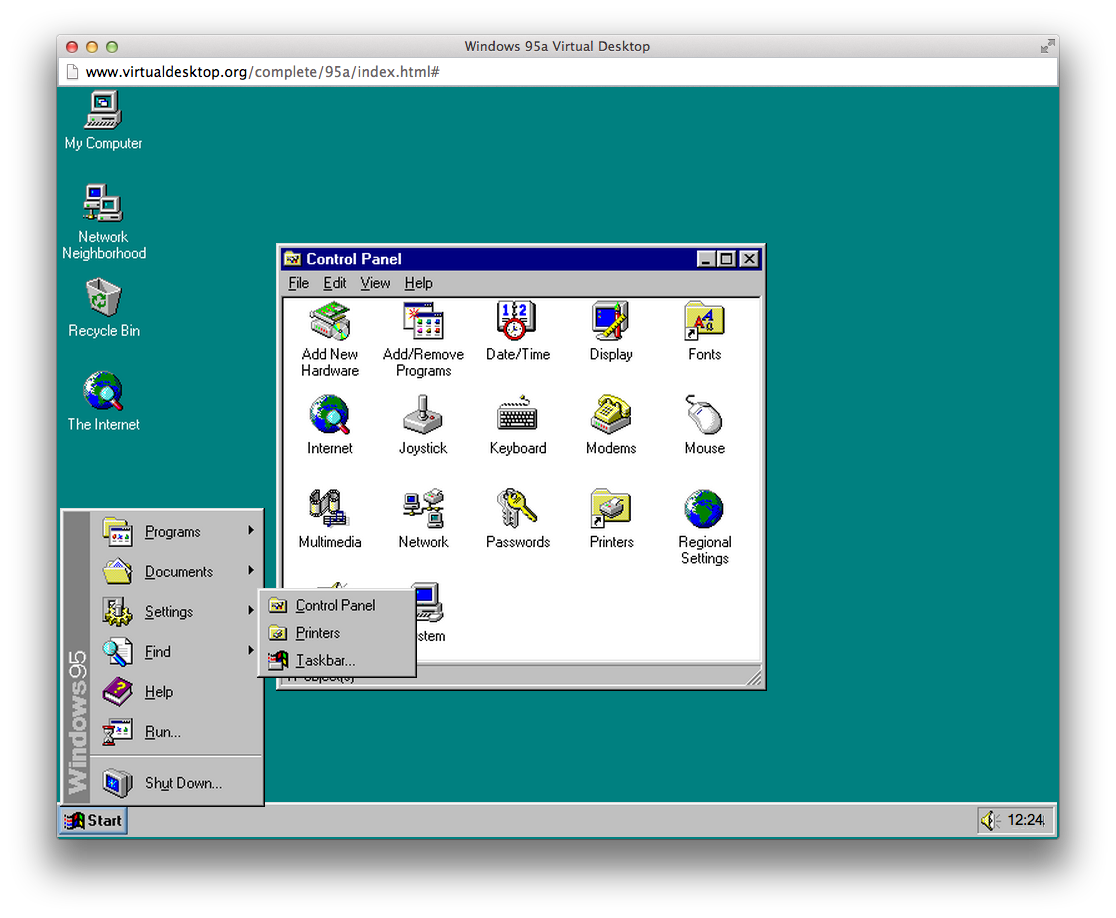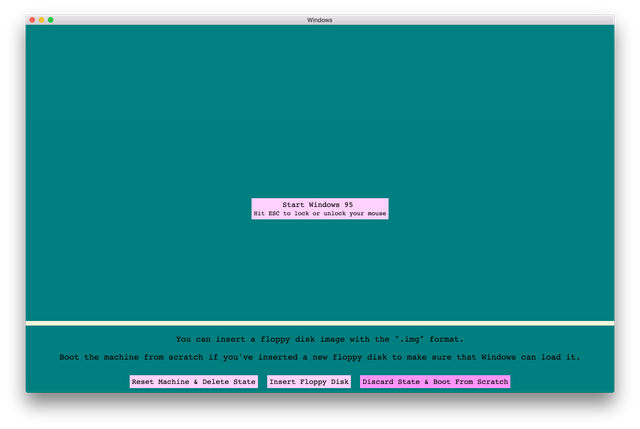Check out how you could still install Windows 95 operating system today by using a VirtualBox virtual machine. See how it works on a modern day Mac Pro OS! The Wine maintenance release 5.0.5 is now available. What's new in this release:. Fixes build failure when v4l is missing; The source is available now.Binary packages are in the process of being built, and will appear soon at their respective download locations. Windows 95 is a consumer-oriented operating system developed by Microsoft as part of its Windows 9x family of operating systems. The first operating system in the 9x family, it is the successor to Windows 3.1x, and was released to manufacturing on August 15, 1995, and generally to retail on August 24, 1995. It was written in late 1996, when Windows 95 was making serious inroads by claiming to be “almost as good as the Mac.” This was not a good time for Apple: Between authorized Mac clones dividing the Mac OS market and Win 95 siphoning off business users, Apple was about to earn the label “beleagueared”. Your Windows computer must have an Intel Core i3, i5, i7 or i9 processor in order to run macOS Catalina, as well as a minimum of four gigabytes of RAM. To check these specs.
25 years ago, Windows 95 was released to great fanfare.
The magazine I worked at back then, MacUser, decided to offer up as a rejoinder a cover that said “Windows 95: So What?” It was originally intended to feature the Windows logo instead of “Windows 95” in type inside a big yellow circle, but the corporate lawyers intervened and said we couldn’t use the logo on our cover. (I always figured that the lawyers were just an excuse, and that our owner didn’t want to overly antagonize Microsoft, since Ziff-Davis also published both PC Magazine and PC/Computing magazine.)
Here’s the truth about Windows 95, though: it was devastating to the Mac. Before Windows 95, PCs were spectacularly bad. (Sorry, fans of Windows 3.1, but it was garbage.) Windows 95, on the other hand, lifted an enormous amount of features from the Mac and drastically improved usability. Long filenames, trash can, aliases, a desktop, easy app switching, the promise of plug-and-play peripherals—these are all things the Mac had and that PCs didn’t, and with the release of Windows 95, the gap between the operating systems closed substantially.
Was Windows 95 better than the Mac? Any Mac user at the time will tell you it absolutely wasn’t. But Windows just being decent made it that much harder to justify buying a Mac in an increasingly Windows-centric environment. Windows 95 didn’t make Windows good, but it made it good enough.
And the technical underpinnings of Windows 95, most notably its support for pre-emptive multitasking, was a shot to the heart of Mac OS. This is a feature that every operating system today has, where the system arbitrates between different processes and doles out processor time. But the classic Mac OS did no such thing. Once an app grabbed control of the processor, it kept it until it relinquished control. If you were downloading a file in the background and then did something in the foreground, that download would just… stop. It was very bad.

At the time Apple was desperately trying to create a re-archictected Mac OS called Copland, which would offer limited preemptive multitasking, with the promise to follow it up with a more robust OS version called Gershwin. A Copland developer preview appeared at WWDC one year—I got the t-shirt!—but was ultimately scrapped. Apple had to turn to outsiders to find a solution to its operating system problems, auditioning BeOS before finally purchasing Next and getting both the foundations of Mac OS X and Steve Jobs at once.
Mac OS X helped Apple build back up the Mac, but in the intervening years, the dominance of Windows accelerated, to the point where Microsoft essentially needed to prop up Apple with investment and promises of future Microsoft Office development in order to prevent the Mac from fading away entirely and giving Microsoft a complete PC monopoly.
Windows 95: So what? It made a huge impact on the Mac, driving Apple to the edge of oblivion. It’s kind of a miracle that the Mac survived it. So there.
If you appreciate articles like this one, support us by becoming a Six Colors subscriber. Subscribers get access to an exclusive podcast, members-only stories, and a special community.
I ran across this memo on my hard drive at work. It was written in late 1996, when Windows 95 was making serious inroads by claiming to be “almost as good as the Mac.” This was not a good time for Apple: Between authorized Mac clones dividing the Mac OS market and Win 95 siphoning off business users, Apple was about to earn the label “beleagueared”.
I share this as an interesting bit of Mac history. My favorite part is Stewart Alsop stating, “Windows is good enough, but just barely.”
Some things never change.
Free Windows Os Systems

Windows 95 Mac App
Memo
- To: Company managers
- From: Dan Knight
- Date: September 6, 1996
- Re: Macintosh vs. Windows 95
The September 5, 1996 issue of The Wall Street Journal had an article emphasizing the corporate switch from Macintosh to the Wintel standard. They did not interview anyone who was sticking with the Macintosh or switching to it, which would have led to more balanced reporting. The article is obviously written with an anti-Mac bias, demonstrated by listing corporations reviewing the status of the Mac with those that have abandoned it. Some very large companies, such as FedEx, are still big Macintosh users.
The article contends that Macintosh is no longer state of the art, which is simply not true. Apple is the primary user of the PowerPC family of microprocessors, which consistently outperforms the Pentium and Pentium Pro from Intel. The Mac OS is tightly coupled to the computer itself, allowing a Mac to automatically recognize a new hard drive or see an inserted floppy disk, things the loosely coupled Intel/Windows world cannot do, since Windows is only a pretty face hiding DOS from the user.
The Journal article points to Stewart Alsop of InfoWorld as a bright example of one Mac user who successfully made the switch. After using Macintosh since 1984, Alsop switched to Windows 95 in July. He has progressively shared his conversion with his readers, as documented in the attached articles. He went from saying, “…I am giving up some things . . . but the plain truth is that I am also getting quite a lot from my transition for giving up what amounts to very little” (July 8, 1996), to “It’s good enough” (July 22), to “Windows is good enough, but just barely.”
Alsop discovered that he has given up more than he bargained for, as documented in these columns. The first shows the “new toy” syndrome: This is as good as my old one, no matter what you say. The second and third columns show a more realistic approach to Windows 95 – but The Wall Street Journal completely ignored these more recent columns.
The only way Windows 95 works is to buy a brand new computer completely set up for your specific needs. Adding a drive, modem, network card, different monitor, memory, and even software is playing Russian roulette with your system. I’ve heard too many horror stories (Jerry Pournelle tells them very well in Byte magazine) about Wintel users making a simple change to their system, then investing hours or days to make everything that had worked before work again.
Or, if you really need a reliable Windows 95 platform, there’s always the add-in card for the Macintosh. Users claim it is easier to work with and more reliable than free standing Windows computers.
Any change from one computer platform to another is a nightmare, as noted in some of the attached articles from the EvangeList mailing list. In the long run, it is far more expensive to run a Windows network – if only because the number of IT employees increases five-fold.
Windows 95 Mac Os Download
The Macintosh is working very well for all of us. I’m grateful there is no compelling reason for us to look into the chaotic world of Wintel computing, with several different versions of the operating system (Windows 3.1, 95, and NT), multiple chip manufacturers and families (Intel 386, 486, Pentium, Pentium Pro; Cyrix; IBM; and others), and hardware incompatibilities among the multitude of clone makers.
Keywords: #macvswindows
Short link: http://goo.gl/ppElU1
searchword: macvswindows95